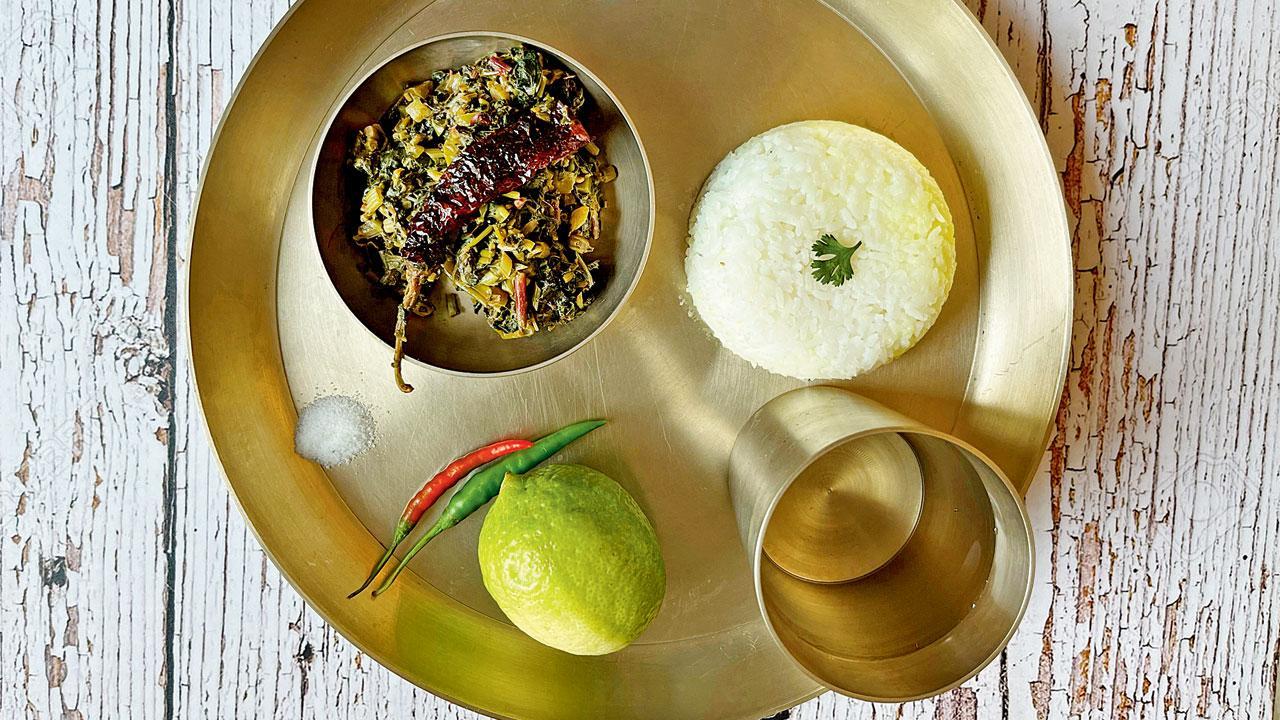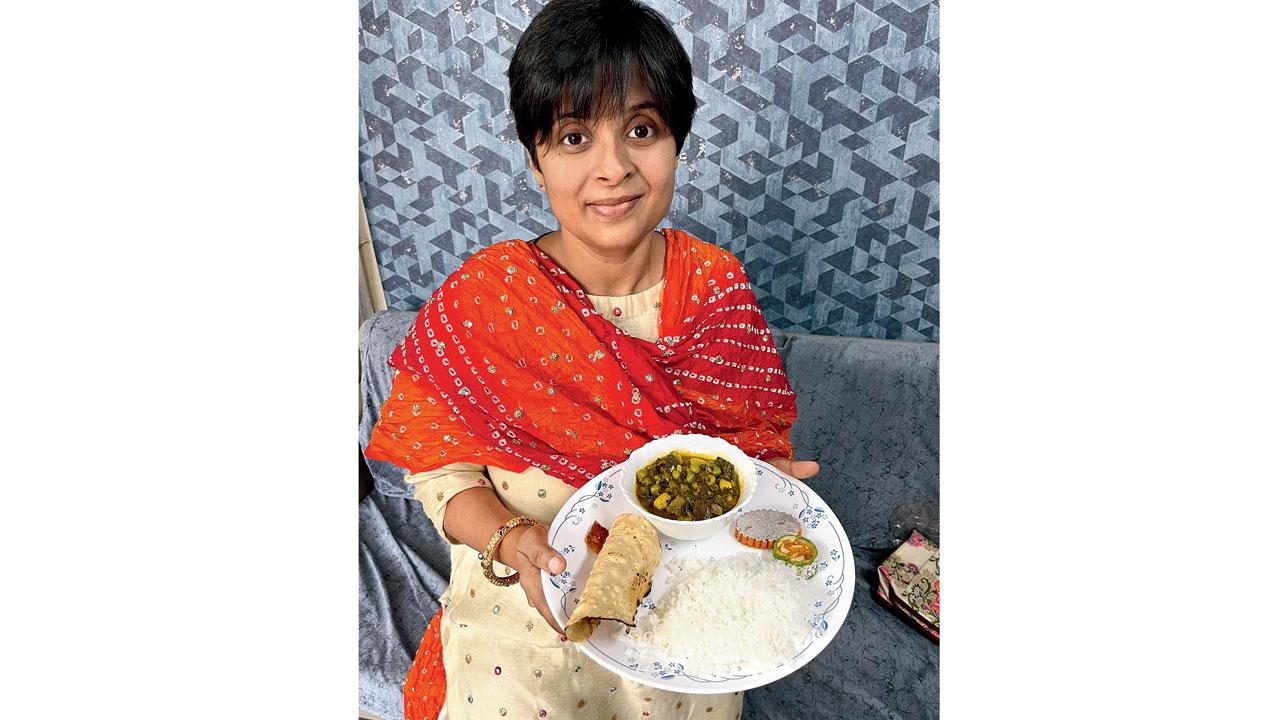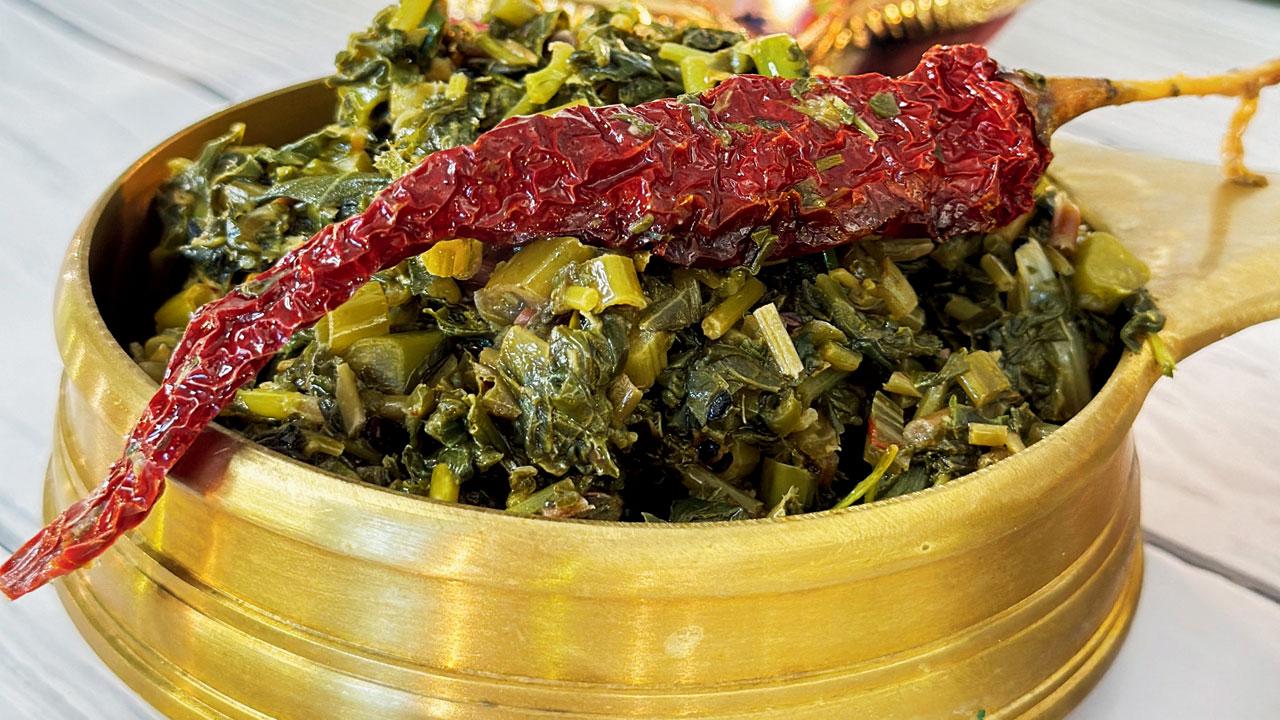The festival of lights also marks the commencement of colder climes and incorporating greens into your meals. Here’s how it starts for most communities in the north

Representation Pic
Last week, chef Ananya Banerjee’s local vegetable vendor at Four Bungalows in Andheri called her to inform excitedly, “Didi, sab shaak aagaya hai.” The leafy green vegetables he was referring to were palong (spinach), laal shaak (red amaranth), kumro (pumpkin leaves), chakundar (beetroot leaves), kolmi (water spinach or taro leaves), pui shaak (malabar spinach), kalmi (watercress), thakur (amaranthus tricolour), methi (fenugreek leaves), dhone (coriander leaves), sojne (moringa leaves), dhutura (Jimson weed), kumra (sweet potato leaves) and neem pata (neem leaves).
During Kali puja—celebrated at the same time as Diwali—Bengalis make choddo shaak with the fourteen vegetables mentioned above. Choddo is 14 in Bengali, and the dish is made a day before Diwali, on Bhoot Chaturdashi. It falls on the 14th day (chaturdashi) of Krishna paksha (dark fortnight) in the month of Ashwin, as per the Hindu calendar. In some homes, the vegetables are cleaned and soaked in water, and later, the water is sprinkled around the house. The belief is that the 14 types of winter greens will appease the soul of 14 purush or ancestors on the night of Bhoot Chaturdashi.

Chef Banerjee tells us, “Traditionally, on Bhoot Chaturdashi, we light lamps and draw designs with rice flour paste known as alpana at the main entrance of the house to ward off evil spirits and to welcome the goddess of wealth, Lakshmi. In some regions of India, especially in Bengal, it is customary to offer prayers to one’s departed ancestors, seek their blessings and peace for the family. The significance of choddo shaak in Kali puja lies in its cultural and religious symbolism. The variety of green leafy vegetables in the dish symbolises abundance, prosperity, and good health. It is also a way to celebrate the harvest season, as many of these vegetables are available only during this time. It is believed that choddo shaak pleases Goddess Kali and brings blessings to the devotees.”
Banerjee’s grandma would caution against turning around or responding when someone calls out your name at night on Bhoot Chaturdashi, as it might be a ghost wanting to possess your body. Variations of this belief can be found in different parts of the world. There is folklore about spirits or ghosts trying to communicate with the living, and it is often advised to not respond if you hear your name being called out, especially at night. “While these tales may not have a basis in scientific fact, they play a significant role in cultural traditions and beliefs,” says Banerjee.
Back to the shaak, Banerjee tells us that it is cooked in mustard oil, as are most dishes in the region. “And while you may not always find all 14 vegetables in Mumbai, feel free to use what’s available and according to your taste preferences. The key is to balance the flavours and textures of the
different leaves,” she adds.

Professor Vidhi Agarwal shares how in the North, annakoot subzi is cooked on the day after Diwali, on Govardhan Puja. PIC/ATUL KAMBLE
Of panchmel or annakoot subzi, Dr Vidhi Agrawal, Professor of Cultural Studies, Mass Media Research, Writing and Editing at a city college, says, “The name [of the dish] depends on the region. In Uttar Pradesh, it is mostly referred to as annakoot subzi, and there are versions. It’s cooked on the day after Diwali—on Govardhan puja which marks the day Lord Krishna lifted the mighty Govardhan mountain to offer refuge to his people from torrential rains. Folklore says that the villagers prepared a huge feast in gratitude to Krishna—the chappan bhog. The subzi is symbolic of this feast because it can be made with five or as many as 56 ingredients. Culturally, the annakoot subzi celebrates the onset of winter harvest—cauliflower, peas, potatoes, beans, brinjal, spinach, and spices. It is eaten with rice, another winter harvest, and kadhi because pulses are paused until summer. Scientifically, it is after this pooja that people resume eating greens and vegetables that were avoided in the summer and monsoon months as they were prone to insects and their larvae. So, people first offer annakoot, the winter harvest to God and include beans, brinjals, florets and greens in their meals.”
Agarwal never quite liked the subzi while growing up, but her father and grandmother always insisted it be prepared. “I started appreciating it only when I understood the interconnection between food, climate and region, and how they became a part of rituals,” she admits. Khar-based Vijay Raheja of Spice Story tells us how the Sindhi favourite, sai bhaaji, is associated with abundance and prosperity since it’s made with freshly harvested veggies. In Sindhi, sai means green and bhaji means vegetables. “Unlike most veggies that reduce in size once cooked, sai bhaji expands. Its green colour, the flavours and the fact that it’s a one-pot dish make it a popular one to be cooked for family gatherings, especially Diwali. When I was growing up, on Diwali day, my father’s sisters would come over with their families. While a spread of dishes was prepared, sai bhaaji was a constant with rice. Slowly, as everyone got busy, those meals became few and eventually disappeared. So, I hold these memories very close to my heart!”
Choddo shaak

Ingredients
1 large bowl 14 leafy greens
2-3 tbsp mustard oil
1 tsp mustard seeds
2-3 green chillies, chopped
2-3 cloves of garlic, chopped
1 medium-sized onion, finely chopped
Salt to taste
1/2 tsp turmeric powder
1/2 tsp red chilli powder (adjust to taste)
1/2 teaspoon cumin powder
1/2 teaspoon coriander powder
Method
Wash and chop the leafy greens: Clean the leafy greens thoroughly in plenty of water. Remove any tough stems and chop the leaves finely. Blanch the greens (optional): If you prefer, you can blanch the greens by briefly immersing them in boiling water, then immediately transferring them to ice water to stop the cooking process. This helps retain their vibrant green colour.
Heat the oil: Heat the mustard oil in a deep pan or kadai over medium heat until it starts to smoke. Then, reduce the heat to low. Add mustard seeds and aromatics: Add mustard seeds and let them splutter. Add chopped green chillies and garlic, and sauté for a minute until aromatic.
Add onions and spices: Add finely chopped onions and sauté until they turn golden brown. Then, add turmeric powder, red chilli powder, cumin powder, and coriander powder. Cook the spices for a couple of minutes.
Add the greens: Add the chopped leafy greens to the pan. Stir well to combine with the spices. Cook on low to medium heat, stirring occasionally, until the greens are wilted and cooked through. This may take about 10-15 minutes.
Season with salt: Add salt to taste and cook until the greens are thoroughly cooked and any excess moisture has evaporated.
Serve: Once the greens are cooked to your liking, remove them from heat. Serve choddo shaak with hot rice.
Anakoot subzi

Ingredients
2 boiled potatoes
2 cups parboiled peas, cauliflower florets, diced carrots
(Add raw banana, sweet potato or any other vegetable of your choice)
2 tbsp diced brinjal
1 cup chopped spinach
1 large tomato, chopped
1/4 tsp turmeric
1/2 tsp jeera
1/4 tsp hing
2 tej patta
1 tsp coriander powder
1/2 tsp red chilli powder
1/2 tsp garam masala
Mustard oil for cooking
Method
Heat oil in a broad based kadhai, and add jeera and tejpatta. Then add hing, followed by the parboiled veggies and spinach. Saute for a minute. Next is tomato and more sauting. Add all the spices, including garam masala, and salt. Mix properly. Pour enough water to submerge the veggies, and cover with lid on. Cook on a slow flame or pressure cook for two to three whistles.
Sai bhaji

Ingredients
1 big bunch spinach
1 small bunch sorrel (khatta)
1 cup dill leaves
1/4 cup methi
1 cup onions
1 tsp red chilli powder
1 cup dill leaves
1 1/2 cup tomatoes
4 green chillies
1 tsp ginger garlic paste
1 cup chana dal
1/2 cup chilka moong dal
1 tsp coriander powder
1/2 cup chopped carrot
1/2 cup chopped eggplant
1/2 cup suran
1/2 cup arbi
1 tsp turmeric
1 tbsp refined oil

Method
Heat oil in a pressure cooker and saute finely chopped onions. Next, slip in chopped tomatoes and saute until softened. Add ginger-garlic paste and cook till it releases oil. Now come finely-chopped vegetables and pre-soaked dal. Saute for three to four minutes. Add all chopped greens, salt, masalas and mix well. Add little water and pressure cook for four to five whistles. Blend lightly with hand mixie, and cook again for three to four minutes.
Serve with rice.
 Subscribe today by clicking the link and stay updated with the latest news!" Click here!
Subscribe today by clicking the link and stay updated with the latest news!" Click here!










